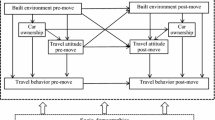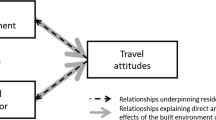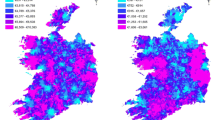Abstract
This paper presents an examination of the significance of residential sorting or self selection effects in understanding the impacts of the built environment on travel choices. Land use and transportation system attributes are often treated as exogenous variables in models of travel behavior. Such models ignore the potential self selection processes that may be at play wherein households and individuals choose to locate in areas or built environments that are consistent with their lifestyle and transportation preferences, attitudes, and values. In this paper, a simultaneous model of residential location choice and commute mode choice that accounts for both observed and unobserved taste variations that may contribute to residential self selection is estimated on a survey sample extracted from the 2000 San Francisco Bay Area household travel survey. Model results show that both observed and unobserved residential self selection effects do exist; however, even after accounting for these effects, it is found that built environment attributes can indeed significantly impact commute mode choice behavior. The paper concludes with a discussion of the implications of the model findings for policy planning.
Similar content being viewed by others
References
Badoe, D.A., Miller, E.J.: Transportation-land-use interaction: empirical findings in North America, and their implications for modeling. Transport. Res. D 5(4), 235–263 (2000)
Bhat, C.R.: Simulation estimation of mixed discrete choice models using randomized and scrambled Halton sequences. Transport. Res. B 37(9), 837–855 (2003)
Bhat, C.R., Guo, J.Y.: A comprehensive analysis of built environment characteristics on household residential choice and auto ownership levels. Transport. Res. B 41(5), 506–526 (2007)
Boarnet, M.G., Sarmiento, S.: Can Land-use Policy Really Affect Travel Behavior? A Study of the Link between Non-work Travel and Land-Use Characteristics. Urban Stud. 35(7), 1155–1169 (1998)
Cao, X., Mokhtarian, P.L., Handy, S.L.: Examining the impacts of residential self-selection on travel behavior: methodologies and empirical findings. Paper presented at the 11th International Association for Travel Behavior Research, Kyoto, August 2006
Cervero, R.: Built environments and mode choice: toward a normative framework. Transport. Res. D 7(4), 265–284 (2002)
Cervero R., Duncan, M.: Residential self selection and rail commuting: a nested logit analysis. Working paper. University of California Transportation Center, Berkeley, CA, 2002. http://www.uctc.net/papers/604.pdf
Cervero, R., Duncan, M.: Walking, bicycling, and urban landscapes: evidence from the San Francisco Bay area. Am. J. Public Health 93(9), 1478–1483 (2003)
Cervero, R., Kockelman, K.: Travel demand and the three D’s: density, diversity and design. Transport. Res. D 2(3), 199–219 (1997)
Cervero, R., Wu, K.: Influences of land use environments on commuting choices: an analysis of large U.S. metropolitan areas using the 1985 american housing survey. Working paper. University of California Transportation Center, Berkeley, CA, 1997. http://www.uctc.net/papers/669.pdf
Crane, R.: The influence of urban form on travel: an interpretive review. J. Plann. Lit. 15(1), 3–23 (2000)
Crane, R., Crepeau, R.: Does neighborhood design influence travel? a behavioral analysis of travel diary and GIS data. Transport. Res. D 3(4), 225–238 (1998)
Ewing, R., Cervero, R.: Travel and the built environment—synthesis. Transport. Res. Rec. 1780, 87–114 (2001)
Ewing, R., Haliyur, P., Page, W.: Getting around a traditional city, a suburban planned unit development, and everything in between. Transport. Res. Rec. 1466, 53–62 (1994)
Frank, L.D., Pivo, G.: Impacts of mixed use and density on the utilization of three modes of travel: single occupant vehicle, transit and walking. Transport. Res. Rec. 1466, 44–52 (1994)
Friedman, B., Gordon, P., Peers, J.: Effect of neotraditional neighborhood design on travel characteristics. Transport. Res. Rec. 1466, 63–70 (1994)
Handy, S.: Methodologies for exploring the link between urban form and travel behavior. Transport. Res. D 1(2), 151–165 (1996)
Hess, D.: Effect of free parking on commuter mode choice—evidence from travel diary data. Transport. Res. Rec. 1753, 35–42 (2001)
Kitamura, R., Mokhtarian, P.L., Laidet, L.: A micro-analysis of land use and travel in five neighborhoods in the San Francisco bay area. Transportation 24(2), 125–158 (1997)
Kockelman, K.M.: Travel behavior as a function of accessibility, land use mixing and land use balance: evidence from the San Francisco Bay area. Transport. Res. Rec. 1607, 116–125 (1997)
MORPACE International, Inc. Bay Area Travel Survey Final Report, March 2002. ftp://ftp.abag.ca.gov/pub/mtc/planning/BATS/BATS2000/
Rajamani, J., Bhat, C.R., Handy, S., Knaap, S., Song, Y.: Assessing impact of urban form measures on nonwork trip mode choice after controlling for demographic and level-of-service effects. Transport. Res. Rec. 1831, 158–165 (2003)
Rodriguez, D.A., Joo, J.: The relationship between non-motorized mode choice and the local physical environment. Transport. Res. D 9(2), 151–173 (2004)
Schwanen, T., Mokhtarian, P.L.: What affects commute mode choice: neighborhood physical structure or preferences toward neighborhoods? J. Transport. Geog. 13(1), 83–99 (2005)
Transportation Research Board and Institute of Medicine (TRB-IOM): Does the built environment influence physical activity? examining the evidence. January, 2005. http://www.onlinepubs.trb.org/onlinepubs/sr/sr282.pdf
Ye, X., Pendyala, R.M., Gottardi, G.: An exploration of the relationship between mode choice and complexity of trip chaining patterns. Transport. Res. B 41(1), 96–113 (2007)
Zhang, M.: The role of land use in travel mode choice: evidence from Boston and Hong Kong. J. Am. Plann. Assoc. 70(3), 344–360 (2004)
Zhang M.: Travel choice with no alternative: can land use reduce automobiledependence? J. Plann. Educ. Res. 25(3), 311–326 (2006)
Acknowledgements
This research has been funded in part by Environmental Protection Agency Grant R831837. The authors would like to thank Jessica Guo and Rachel Copperman for providing help with data related issues. Thanks to Lisa Macias for her help in formatting this document. Four anonymous referees provided valuable comments on an earlier version of this paper.
Author information
Authors and Affiliations
Corresponding author
Rights and permissions
About this article
Cite this article
Pinjari, A.R., Pendyala, R.M., Bhat, C.R. et al. Modeling residential sorting effects to understand the impact of the built environment on commute mode choice. Transportation 34, 557–573 (2007). https://doi.org/10.1007/s11116-007-9127-7
Published:
Issue Date:
DOI: https://doi.org/10.1007/s11116-007-9127-7




